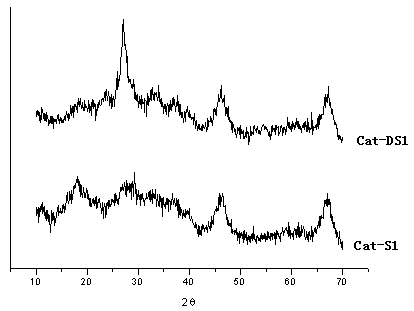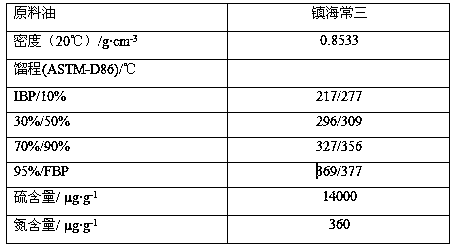A method for recycling hydrogenation catalyst waste
A technology for hydrogenation catalysts and waste materials is applied in the field of recycling and reuse of hydrogenation catalyst waste materials, which can solve problems such as affecting the physicochemical properties of catalysts, and achieve the effects of efficient recovery, high activity, and reduced viscosity and acidity.
- Summary
- Abstract
- Description
- Claims
- Application Information
AI Technical Summary
Problems solved by technology
Method used
Image
Examples
Embodiment 1
[0047] Hydrogenation catalyst waste (containing 12 wt% MoO 3 and 2.1 wt% CoO, the balance being alumina) and weighed 15g after passing through a 200-mesh sieve. Add it to 20g of water for dispersion, then add 15g of 30% nitric acid, 10.5g of 85% phosphoric acid, 7.5g of tartaric acid and 65g of mixed acid solution of water. At this time, the mass ratio of nitric acid-phosphoric acid-organic acid-waste material-water is 0.3:0.6:0.5:1:6.8. Then the temperature was raised to 90° C., and then kept at the temperature for 60 minutes. After cooling to room temperature, 3 g of monoethanolamine was added to obtain the final waste material sol slurry.
[0048] Put 105g of macroporous alumina powder (dry basis 85) in the rolling pan, and spray 80ml of 18.5g of cobalt nitrate and 3.0g of oxalic acid into the macroporous alumina powder in the rolling pan under the condition of rotation. Aqueous solution, after the solution is sprayed, continue to rotate in the rolling pot for 30 minutes,...
Embodiment 2
[0053] Hydrogenation catalyst waste (containing 22.5 wt%MoO 3 and 3.1 wt% CoO, the balance being alumina) and weighed 20g after passing through a 200-mesh sieve. Add to 25g water for dispersion, then add 40g of 30% nitric acid, 14.1g of 85% phosphoric acid, 4g of citric acid and 35g of mixed acid solution of water. At this time, the mass ratio of nitric acid-phosphoric acid-organic acid-waste material-water is 0.6:0.6:0.2:1:4.5. Then heat up to 90°C and keep the temperature for 60 minutes, then add 4g of ethylenediamine after cooling to room temperature to obtain the final waste material sol slurry.
[0054] Put 172g of macroporous alumina powder (dry basis 85) in the rolling pan, and spray 140ml of 32g of cobalt nitrate and 1.9g of citric acid into the macroporous alumina powder in the rolling pan under the condition of rotation. Aqueous solution, after the solution is sprayed, continue to rotate in the rolling pot for 30 minutes, then place it for 3 hours, dry it at 110°C ...
Embodiment 3
[0059] Hydrogenation catalyst waste (containing 18.7 wt%MoO 3 and 2.8 wt% CoO, the balance being alumina) and weighed 18g after passing through a 200-mesh sieve. Add it to 18g of water for dispersion, then add 15g of 30% nitric acid, 10.6g of 85% phosphoric acid, 5.4g of malic acid and 50g of mixed acid solution of water. At this time, the mass ratio of nitric acid-phosphoric acid-organic acid-waste material-water is 0.25:0.5:0.3:1:4.45. Then the temperature was raised to 85° C., and then kept at the temperature for 60 minutes. After cooling to room temperature, 2 g of isopropylamine was added to obtain the final waste material sol slurry.
[0060] Put 100g of macroporous alumina powder (dry basis 85) in the rolling pan, and spray 80ml of 18.5g of cobalt nitrate and 3.5g of tartaric acid into the macroporous alumina powder in the rolling pan under the condition of rotation. Aqueous solution, after the solution is sprayed, continue to rotate in the rolling pot for 30 minutes,...
PUM
| Property | Measurement | Unit |
|---|---|---|
| specific surface area | aaaaa | aaaaa |
| pore size | aaaaa | aaaaa |
| specific surface area | aaaaa | aaaaa |
Abstract
Description
Claims
Application Information
 Login to View More
Login to View More - R&D
- Intellectual Property
- Life Sciences
- Materials
- Tech Scout
- Unparalleled Data Quality
- Higher Quality Content
- 60% Fewer Hallucinations
Browse by: Latest US Patents, China's latest patents, Technical Efficacy Thesaurus, Application Domain, Technology Topic, Popular Technical Reports.
© 2025 PatSnap. All rights reserved.Legal|Privacy policy|Modern Slavery Act Transparency Statement|Sitemap|About US| Contact US: help@patsnap.com



